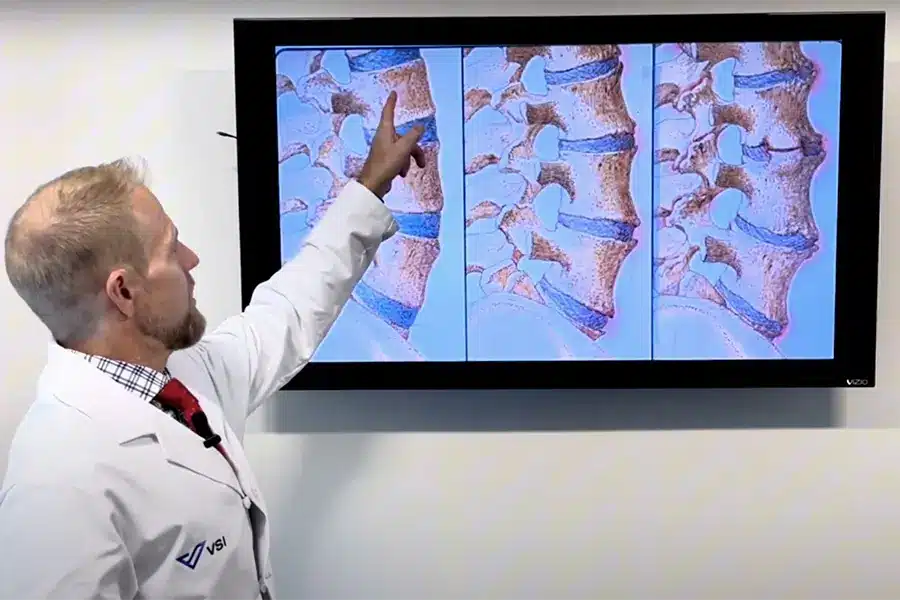
Understanding Lumbar Spinal Stenosis: Causes, Symptoms, and Treatment Options
Lumbar spinal stenosis is a medical condition that can cause significant discomfort and impact daily life. We’ll break down what lumbar spinal stenosis is, its symptoms, causes, and treatment options, providing a comprehensive guide for those seeking to understand this condition better.
What is Lumbar Spinal Stenosis?
The term stenosis means a narrowing of space, and in the context of the spine, it refers to a reduction in the space available for the nerves in the lower back (lumbar spine). This narrowing can compress the nerves, leading to various symptoms.
Types of Stenosis
Congenital Stenosis
Some individuals are born with less space around their spinal nerves, known as congenital stenosis. This isn’t necessarily problematic unless other factors exacerbate the narrowing over time.
Acquired Stenosis
As we age, our spinal discs may degenerate, and arthritis or bone spurs can contribute to narrowing, resulting in what is known as acquired stenosis.
Watch the Video on Youtube
Symptoms of Lumbar Spinal Stenosis
Common symptoms of lumbar spinal stenosis include low back pain that often radiates to the buttocks and legs, along with leg weakness or numbness that worsens with prolonged walking or standing. Many patients experience relief when sitting or leaning forward, such as while using a shopping cart, as this position eases nerve compression. In severe cases, limited mobility becomes a significant concern, restricting daily activities and overall quality of life.
Causes of Lumbar Spinal Stenosis
Degenerative Changes
Aging is a leading cause of lumbar spinal stenosis, as spinal discs lose elasticity and vertebrae shift closer together. This narrowing of the spinal canal is often worsened by arthritis, which causes inflammation and thickening of joints and ligaments, further reducing space for spinal nerves.
Disc Bulging
Bulging discs are a common cause of lumbar stenosis. When discs deteriorate or become damaged, they can protrude into the spinal canal, compressing nerves and causing pain, numbness, or weakness. Disc bulging often occurs alongside other degenerative spine changes.
Bone Spurs
Bone spurs, or osteophytes, develop as a response to arthritis and degeneration. These abnormal growths can encroach into the spinal canal, pinching nerves and narrowing the available space. Bone spurs are a frequent contributor to lumbar spinal stenosis and its symptoms.
Diagnosing Lumbar Spinal Stenosis
Diagnosing lumbar spinal stenosis involves a thorough evaluation of the patient’s history, symptoms, and imaging studies. Doctors begin by discussing hallmark symptoms such as increased pain during walking that improves with sitting or leaning forward. Advanced imaging tests like MRI scans offer detailed views of the spinal canal, highlighting areas where nerves might be pinched, while X-rays help identify bone-related causes such as arthritis or fractures. Cross-sectional imaging further reveals the degree of stenosis, showing how severe narrowing compresses nerves and transforms open spaces into tight, constricted areas, aiding in a precise diagnosis.
Treatment for Lumbar Spinal Stenosis
Non-Surgical Treatments
- Physical Therapy: Strengthening the core and improving posture through physical therapy can alleviate symptoms.
- Weight Management: Reducing body weight decreases stress on the lumbar spine.
- Injections: Steroid injections around the nerves can provide temporary relief and help pinpoint the pain source.
Surgical Treatments
When non-surgical methods fail, surgery may be recommended. The type of surgery depends on the severity and causes of the stenosis.
Decompression Surgery
Decompression surgery involves removing parts of the bone or ligaments to relieve pressure on nerves. Minimally invasive techniques preserve stability by keeping key spinal structures intact.
Fusion Surgery
If spinal instability is a concern, spinal fusion surgery may be performed to stabilize the spine after decompressing the nerves.
Minimally Invasive Procedures
Instead of removing large sections of bone, surgeons make small openings to relieve nerve compression while preserving muscles and ligaments, using minimally invasive techniques.
Avoiding Failed Back Surgery Syndrome
A failed back surgery occurs when the patient’s pain persists after surgery, often because the root cause wasn’t adequately addressed. To prevent this, it’s crucial to pinpoint pain sources through using diagnostic injections to identify whether the pain stems from stenosis, arthritis, or disc degeneration. It is also important to customize surgical plans and ensure the procedure targets the exact cause of pain.
Lumbar spinal stenosis is a common condition that can significantly impact mobility and quality of life. However, advancements in diagnostics and treatment options, from conservative therapies to minimally invasive surgeries, offer hope for those affected. If you’re experiencing symptoms of lumbar spinal stenosis, consult a spine surgeon for an accurate diagnosis and personalized treatment plan. Understanding your condition is the first step toward relief and restored function.
Topics covered
About the Author
Featured Resources
Insights to Achieve a Pain-Free Life



